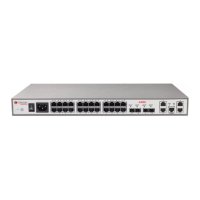A10E/A28E/A28F Configuration Guide
Figure 6-4 Configuring RADIUS 169
Figure 6-5 Configuring TACACS+ 174
Figure 6-6 Configuring storm control 177
Figure 6-7 802.1x structure 178
Figure 6-8 Configuring 802.1x 183
Figure 6-9 IP Source Guard principle 185
Figure 6-10 Configuring IP Source Guard 189
Figure 6-11 Accessing the network through PPPoE authentication 191
Figure 6-12 Configuring PPPoE+ 196
Figure 6-13 Loopback detection networking 198
Figure 6-14 Loopback detection application 201
Figure 6-15 Line detection application networking 203
Figure 7-1 Configuring manual link aggregation 210
Figure 7-2 Configuring static LACP link aggregation 211
Figure 7-3 Principles of interface backup 214
Figure 7-4 Application of interface backup in different VLANs 214
Figure 7-5 Configuring interface backup 217
Figure 7-6 Configuring failover 221
Figure 7-7 Network storm due to loopback 223
Figure 7-8 Loop networking with STP 224
Figure 7-9 VLAN packet forward failure due to RSTP 225
Figure 7-10 STP application networking 227
Figure 7-11 Basic concepts of the MSTI network 231
Figure 7-12 MSTI concepts 232
Figure 7-13 Networking of multiple spanning trees instances in MST domain 233
Figure 7-14 MSTP application networking 243
Figure 7-15 RRPS in normal status 255
Figure 7-16 RRPS in switching status 256
Figure 7-17 RRPS application networking 259
Figure 8-1 OAM classification 263
Figure 8-2 Configuring EFM 269
Figure 8-3 Different MD Levels 271
Figure 8-4 Network Sketch Map of MEP and MIP 272
Figure 8-5 CFM application 280
Figure 8-6 SLA application networking 286
Figure 9-1 Working mechanism of SNMP 289
Figure 9-2 SNMP v3 authentication mechanism 293
Figure 9-3 Configuring SNMP v1/v2c and Trap 296
Figure 9-4 Configuring SNMP v3 and Trap 298
Figure 9-5 Configuring KeepAlive 302
Figure 9-6 RMON 303
Figure 9-7 Configuring RMON alarm group 307
Figure 9-8 LLDPDU structure 309
Figure 9-9 Basic TLV structure 309
Figure 9-10 Configuring basic functions of LLDP 314
Figure 9-11 Extended OAM application networking 316
Figure 9-12 Configuring extended OAM to manage the remote device 331
Figure 9-13 Outputting system logs to log servers 338

